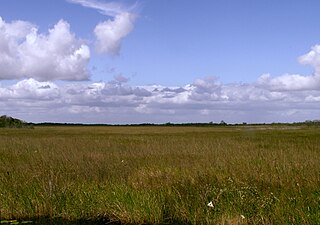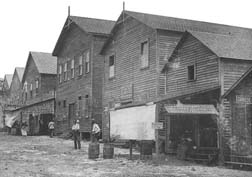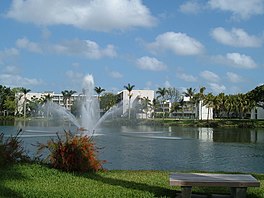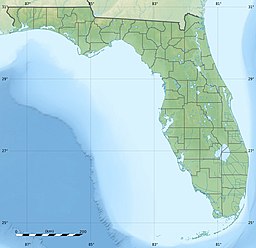
The Everglades is a natural region of flooded grasslands in the southern portion of the U.S. state of Florida, comprising the southern half of a large drainage basin within the Neotropical realm. The system begins near Orlando with the Kissimmee River, which discharges into the vast but shallow Lake Okeechobee. Water leaving the lake in the wet season forms a slow-moving river 60 miles (97 km) wide and over 100 miles (160 km) long, flowing southward across a limestone shelf to Florida Bay at the southern end of the state. The Everglades experiences a wide range of weather patterns, from frequent flooding in the wet season to drought in the dry season. Throughout the 20th century, the Everglades suffered significant loss of habitat and environmental degradation.

The University of Miami is a private research university in Coral Gables, Florida. As of 2022, the university enrolled 19,402 students in 12 colleges and schools across nearly 350 academic majors and programs, including the Leonard M. Miller School of Medicine in Miami's Health District, the law school on the main campus, and the Rosenstiel School of Marine, Atmospheric, and Earth Science on Virginia Key with research facilities in southern Miami-Dade County.

North Miami is a suburban city located in northeast Miami-Dade County, Florida, United States, about 10 miles (16 km) north of Miami. The city lies on Biscayne Bay and hosts the Biscayne Bay Campus of Florida International University.. Originally the town of "Arch Creek", the area was incorporated as the "Town of Miami Shores", which was renamed the "Town of North Miami" in 1931. It was reincorporated as a city in 1953. The city is part of the Miami metropolitan area of South Florida.

Biscayne National Park is an American national park located south of Miami, Florida in Miami-Dade County. The park preserves Biscayne Bay and its offshore barrier reefs. Ninety-five percent of the park is water, and the shore of the bay is the location of an extensive mangrove forest. The park covers 172,971 acres and includes Elliott Key, the park's largest island and northernmost of the true Florida Keys, formed from fossilized coral reef. The islands farther north in the park are transitional islands of coral and sand. The offshore portion of the park includes the northernmost region of the Florida Reef, one of the largest coral reefs in the world.

Everglades National Park is an American national park that protects the southern twenty percent of the original Everglades in Florida. The park is the largest tropical wilderness in the United States and the largest wilderness of any kind east of the Mississippi River. An average of one million people visit the park each year. Everglades is the third-largest national park in the contiguous United States after Death Valley and Yellowstone. UNESCO declared the Everglades & Dry Tortugas Biosphere Reserve in 1976 and listed the park as a World Heritage Site in 1979, and the Ramsar Convention included the park on its list of Wetlands of International Importance in 1987. Everglades is one of only three locations in the world to appear on all three lists.

Florida International University (FIU) is a public research university with its main campus in the neighborhood of University Park in Westchester, Miami-Dade County, Florida. Founded in 1965 by the Florida Legislature, the school opened its doors to students in 1972. FIU has grown to become the third-largest university in Florida and the eighth-largest public university in the United States by enrollment. FIU is a constituent part of the State University System of Florida.

Hazing, initiation, beasting, bastardisation, ragging or deposition refers to any activity expected of someone in joining or participating in a group that humiliates, degrades, abuses, or endangers them regardless of a person's willingness to participate.

Lake Okeechobee, also known as Florida's Inland Sea, is the largest freshwater lake in the U.S. state of Florida. It is the tenth largest natural freshwater lake among the 50 states of the United States and the second-largest natural freshwater lake contained entirely within the contiguous 48 states, after Lake Michigan.

Biscayne Bay is a lagoon with characteristics of an estuary located on the Atlantic coast of South Florida. The northern end of the lagoon is surrounded by the densely developed heart of the Miami metropolitan area while the southern end is largely undeveloped with a large portion of the lagoon included in Biscayne National Park.

Pi Kappa Alpha (ΠΚΑ), commonly known as PIKE, is a college fraternity founded at the University of Virginia in 1868. The fraternity has over 225 chapters and colonies across the United States and abroad with over 15,500 undergraduate members and over 300,000 lifetime initiates.

Beta Theta Pi (ΒΘΠ), commonly known as Beta, is a North American social fraternity that was founded in 1839 at Miami University in Oxford, Ohio. One of North America's oldest fraternities, as of August 2023 it consists of 142 active chapters and colonies in the United States and Canada. More than 219,000 members have been initiated worldwide and there are currently around 8,500 undergraduate members. Beta Theta Pi is the oldest of the three fraternities that formed the Miami Triad, along with Phi Delta Theta and Sigma Chi.

The Kissimmee River is a river in south-central Florida, United States that forms the north part of the Everglades wetlands area. The river begins at East Lake Tohopekaliga south of Orlando, flowing south through Lake Kissimmee into the large, shallow Lake Okeechobee. Hurricane-related floods in 1947 prompted channelization of the meandering lower stretch, completed by 1970. The straightened course reduced wetland habitat and worsened pollution. In response, efforts since the 1990s have partially restored the river's original state and revitalized the ecosystem, as part of the broader restoration of the Everglades.

Thousands of years before Europeans arrived, a large portion of south east Florida, including the area where Miami, Florida exists today, was inhabited by Tequestas. The Tequesta Native American tribe, at the time of first European contact, occupied an area along the southeastern Atlantic coast of Florida. They had infrequent contact with Europeans and had largely migrated by the middle of the 18th century. Miami is named after the Mayaimi, a Native American tribe that lived around Lake Okeechobee until the 17th or 18th century.

Kappa Alpha Psi Fraternity, Inc. (ΚΑΨ) is a historically African American fraternity. Since the fraternity's founding on January 5, 1911 at Indiana University Bloomington, the fraternity has never restricted membership on the basis of color, creed or national origin though membership traditionally is dominated by those of African heritage. The fraternity has over 160,000 members with 721 undergraduate and alumni chapters in every state of the United States, and international chapters in the United Kingdom, Germany, South Korea, Japan, United States Virgin Islands, Nigeria, South Africa, and The Bahamas.

Sigma Phi Epsilon (ΣΦΕ), commonly known as SigEp, is a social college fraternity for male college students in the United States. It was founded on November 1, 1901, at Richmond College, which is now the University of Richmond, and its national headquarters remains in Richmond, Virginia. It was founded on three principles: Virtue, Diligence, and Brotherly Love. Sigma Phi Epsilon is one of the largest social fraternities in the United States in terms of current undergraduate membership.

The environment of Florida in the United States yields an array of land and marine life in a mild subtropical climate. This environment has drawn millions of people to settle in the once rural state over the last hundred years. Florida's population increases by about 1,000 residents each day. Land development and water use have transformed the state, primarily through drainage and infill of the wetlands that once covered most of the peninsula.

Kappa Sigma (ΚΣ), commonly known as Kappa Sig or KSig, is an American collegiate social fraternity founded at the University of Virginia in 1869. Kappa Sigma is one of the five largest international fraternities with currently 318 active chapters and colonies in North America. Its endowment fund, founded in 1919, has donated more than $5 million to undergrads since 1948. In 2012 alone, the Fraternity's endowment fund raised over $1 million in donations.

A national push for expansion and progress toward the latter part of the 19th century stimulated interest in draining the Everglades, a region of tropical wetlands in southern Florida, for agricultural use. According to historians, "From the middle of the nineteenth century to the middle of the twentieth century, the United States went through a period in which wetland removal was not questioned. Indeed, it was considered the proper thing to do."
The Andrew Coffey lawsuit involved the death of a young man who was killed in November 2017 during a fraternity event, triggering an anti-hazing movement in Florida. On November 3, 2017, Florida State University junior Andrew Coffey was killed by acute alcohol poisoning after participating in Big Brother Night, a fraternity event hosted by Pi Kappa Phi. Coffey was found unresponsive on a couch the morning after the event, and his death became part of a national wave of criticism of fraternity hazing practices. Members of the fraternity were eventually prosecuted for their role in Andrew Coffey's death, with three former fraternity leaders awaiting trial as of December 2018.



















